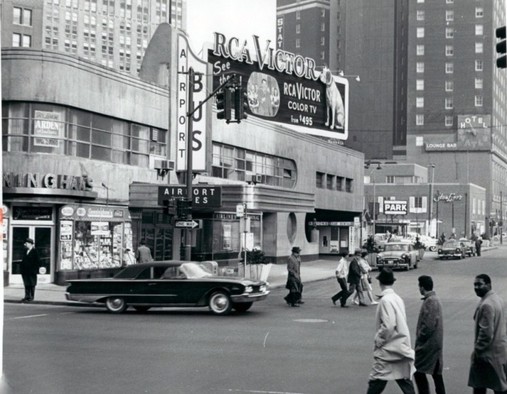

The site of Lafayette Park has a long, controversial history that precedes the modernist urban development. Centuries before Lafayette Park was built, French settlers farmed the area and named it “Black Bottom” for its dark, fertile soil and low elevation. In the twentieth century, Black Bottom became one of the most vibrant African American districts in Detroit.
Located northeast of downtown, Black Bottom was bound by Gratiot, Brush, Vernor and the Grand Trunk Railroad. In the early 1900s, many African Americans migrated north to Detroit seeking employment in the city’s growing industries. Racially discriminatory housing covenants forced most of them to settle in Black Bottom.
As thousands of blacks streamed into Black Bottom, the community swelled. The name of the neighborhood is often erroneously believed to be a reference to black people, but was given to the area by the original French settlers for its dark topsoil. The Black Bottom–Paradise Valley became known for its significant contribution to American music including Blues, Big Band, and Jazz from the 1930s to the 1950sd with vibrant cultural, educational and social amenities.
The district reached its social, cultural and political peak in 1920. Blacks owned 350 businesses in Detroit, most within Black Bottom. The community additionally boasted 17 physicians, 22 lawyers, 22 barbershops, 13 dentists, 12 cartage agencies, 11 tailors, 10 restaurants, 10 real estate dealers, 8 grocers, 6 drugstores, 5 undertakers, 4 employment agencies, and 1 candy maker (Williams).
The area’s main commercial avenues were Hastings and St. Antoine streets. An adjacent north-bordering area known as Paradise Valley contained night clubs where famous Blues, Big Band, and Jazz artists such as Billie Holiday, Sam Cooke, Ella Fitzgerald, Duke Ellington, Billy Eckstine, Pearl Bailey, and Count Basie regularly performed. In 1941, the city’s Orchestra Hall was named Paradise Theatre. Aretha Franklin’s father, the late Reverend C. L. Franklin, first opened his New Bethel Baptist Church on Hastings Street. Hastings Street, which ran north-south through Black Bottom, had been an area populated by immigrants before World War I.
Black Bottom endured the Great Depression, with many of its residents working in factories. Following World War II, the physical structures of Black Bottom were in need of replacement.
In the early 1960s, the City of Detroit demolished the Black Bottom district as part of an urban renewal project. The area was replaced by the Chrysler Freeway (Interstate 75 and Interstate 375) and Lafayette Park, a residential development designed by Mies van der Rohe and intended as a model neighborhood. It combined residential townhouses, apartments and high-rises with commercial areas. Many of the residents relocated to large public housing projects such as the Brewster-Douglass Housing Projects Homes and Jeffries Homes.
